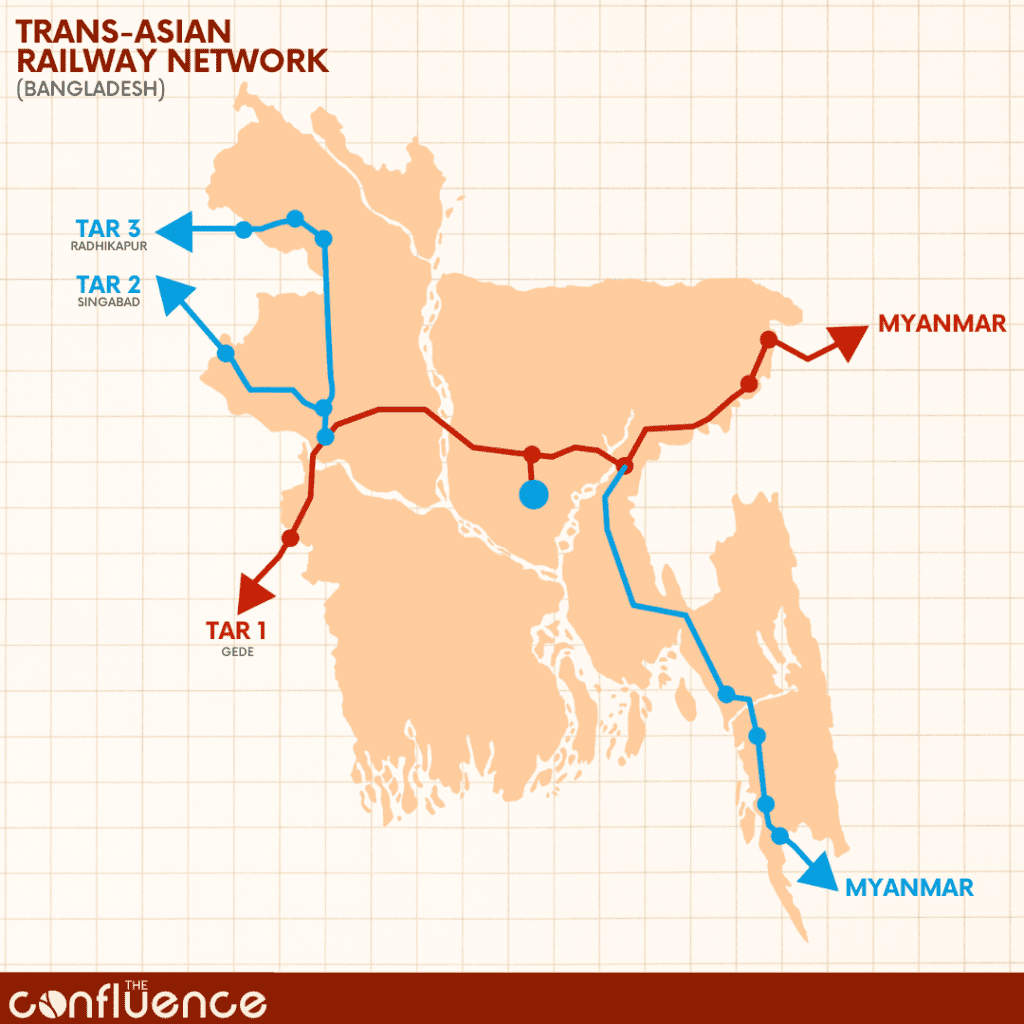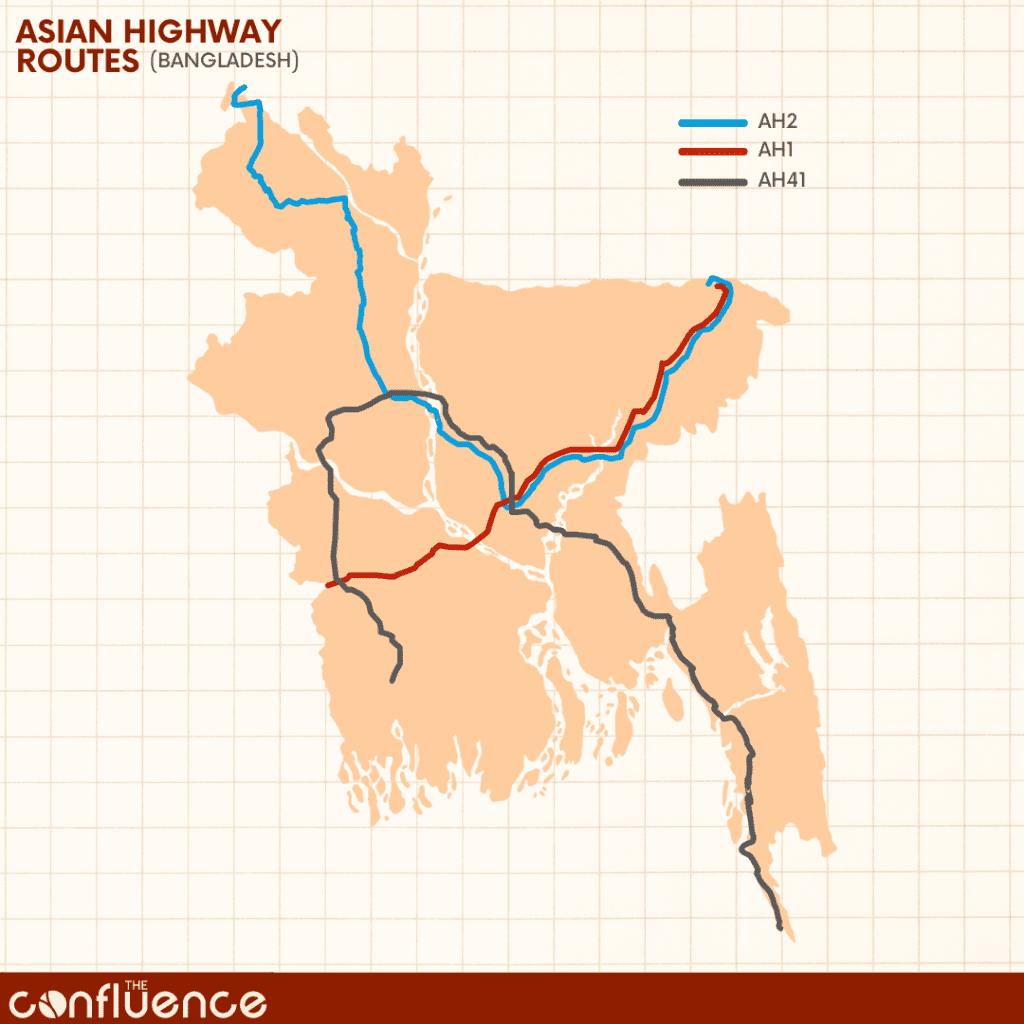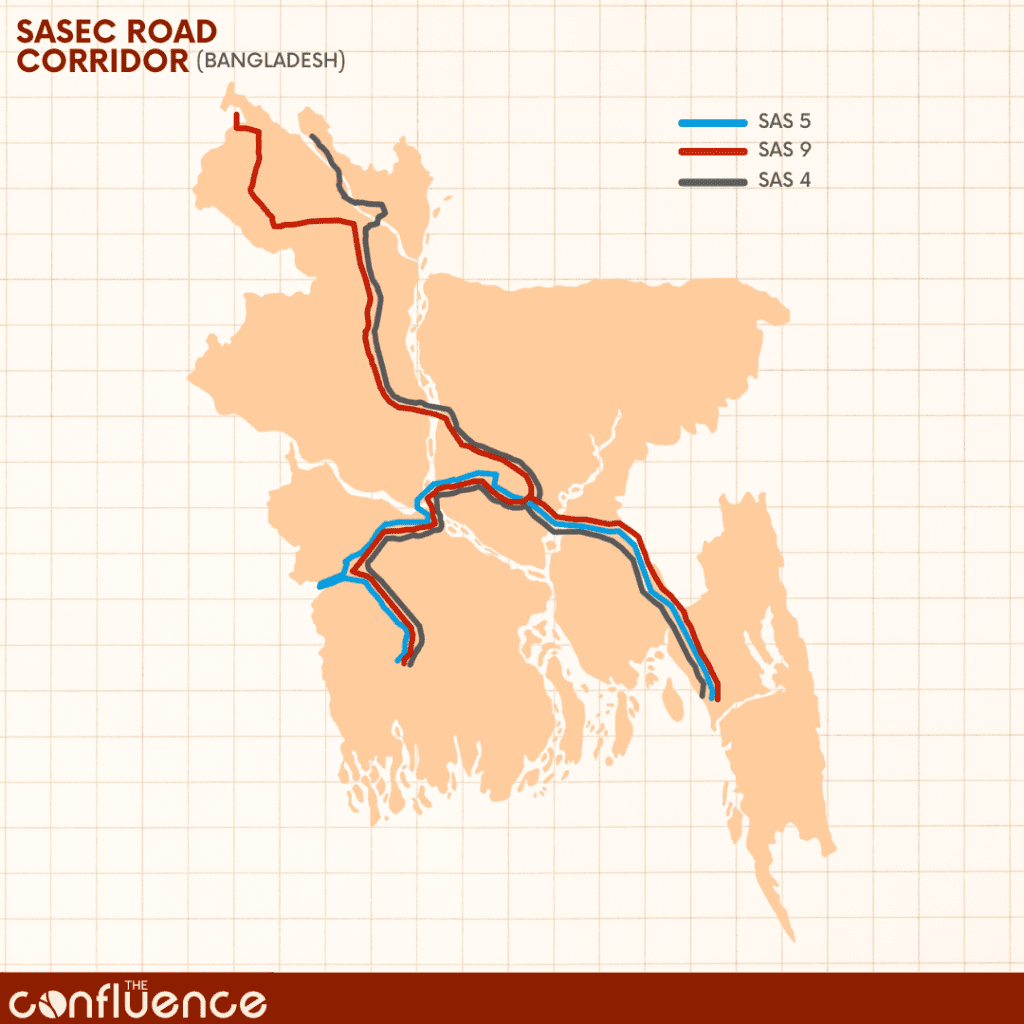In over 50 years of existence since 1967, ASEAN, a bloc that started with 5 member states initially, has today emerged as a multifaceted regional community of 11 nations. It is one of the World’s largest blocs amounting to US $3.6 Trillion GDP(PPP) which is 6.5% of global GDP. 60 percent of all shipping trade passes through the strait of Malacca, a narrow sea corridor passing between the Eastern coast of the Indonesian island of Sumatra and the Western coast of Malaysia, two ASEAN bloc countries.
ASEAN – At a glance
US $
0
Tn
GDP (PPP) of ASEAN
6.5% of Global GDP
Produced by ASEAN
60% of All Shipping Trade
Passes through Malacca straight
ASEAN countries signed the Asian Free Trade Agreement (AFTA) in 1992. Although the group came into formation in 1967, it started to emerge as a true regional bloc for the Asian nations in the 90s through ASEAN Regional Forum (ARF) and several bilateral and multilateral integration with other Asian, European and Western nations.
Bangladesh in ASEAN Regional Forum (ARF)
0
th
Member of ARF in 2006
271 Kilometers
Border with Myanmar
Regional Connectivity Hub
Between South Asia, North-west Asia, Middle East and Southeast Asia
Bangladesh became the 26th member of the ARF in 2006. It shares a narrow border of 271 kilometers with Myanmar, an ASEAN member state. Geographically, Bangladesh is positioned to create regional connectivity between South Asia, North-West Asia, Middle East and Southeast Asian nations. With 160 million population and one the fastest growing economies the relationship between Bangladesh and ASEAN appears to be in a logical and gradual progression.
Bangladesh’s Foreign Policy Initiatives to Foster Regional Cooperation
Bangladesh wants to become a sectoral dialogue partner to the ASEAN bloc by the next ASEAN summit to be held in Vientiane in October 2024. Currently major Western, Asian, and African economies such as India, Japan, China, US, Russia, Australia, EU are all full dialogue partners to the bloc and many of these nations have Comprehensive Strategic Partnership with ASEAN.
FTA and PTA for Post-LDC Graduation
As Bangladesh is scheduled to graduate from LDC by 2026, it is currently negotiating bilateral and multilateral agreements to tackle the challenges of the post LDC graduation era. It established SAARC in 1985, a regional bloc of South Asian nations to foster deeper cooperation. It also established the Bay of Bengal Initiative for Multi Sectoral Technical and Economic Cooperation (BIMSTEC) in 1997 with South Asian and Southeast Asian nations. Thailand and Myanmar, two ASEAN bloc nations are part of BIMSTEC.
Bangladesh is actively pursuing greater economic integration with Asian countries and reducing reliance on Western nations to build better resilience to global economic uncertainties. It is pursuing bilateral Free Trade Agreements(FTA) with eleven nations and Preferential Trade Agreements(PTA) with forty four nations.
Transit and Transshipment
In Prime Minister Sheikh Hasina’s recent trip to Thailand a Letter of Intent (LOI) was signed to commence negotiations on a free trade agreement by the end of year 2024. Bangladesh currently has a transit and transhipment agreement in place with India to use Chittagong and Mongla port for goods shipment from mainland India to the North-eastern region. Apart from that Bangladesh and Bhutan have a transit agreement since 2023 to use Bangladesh’s land, sea, and air routes for Bhutan’s export to third countries. This agreement has paved the way for Bangladesh to trade with China using Bhutan’s road network in future.
Bangladesh’s Economic and Connectivity advancement
Bangladesh’s geographic location allows it to be a bridge between South and South Eastern countries. The country in the last one decade has achieved sustained economic growth, infrastructural development and stability. Bangladesh, a critical partner in several regional and sub-regional connectivity initiatives that includes South Asia Subregional Economic Cooperation (SASEC), Trans-Asian Railway and Asian Highway has made regional connectivity a critical component of its economic growth and foreign policy.
In a bid to become a global and regional supply chain center by deepening connectivity with SAARC nations Bangladesh has achieved remarkable development in the connectivity sector as it has opened up it’s ports, railroads, and river system in a seamless way with the goal to create a contiguous landscape from the Far East through Bangladesh to India and beyond.
Trans Asian Railway
0
Countries to be connected through the railway
12 Landlocked Countries
To be connected through the railway
Connected to Thailand and China via Myanmar and Malaysia
With three proposed routes in Bangladesh
Bangladesh joined the UNESCAP proposed Trans Asian Railway (TAR) network during the caretaker government in 2007. The network aims to connect Europe through Asia. Consequently, a southern corridor Bangladesh is now connected to Thailand and the southern province of Yunnan, China. A sub-regional network will cover the ASEAN and Indo-China sub-regions.

Under the TAR network, three proposed routes will pass through Bangladesh. The rail line will connect neighboring Myanmar via Ghundum, and will be expanded to China, Malaysia, and Thailand. Under the TAR network, 12 landlocked countries in Asia will be benefitted as the TAR network connects 28 countries in total.
Asian Highway Network
0
Routes in Total
3 Routes through Bangladesh
AH1, AH2, AH4
32 Nations
To be connected
1771 KM planned through Bangladesh
Of 144630 km in total
300 KM completed through Bangladesh
Of 1771 km proposed
The Asian Highway Network that is supposed to pass through Dhaka and connect Istanbul to Tokyo has not seen significant progress. Out of 88 different routes, three routes – AH1, AH2, and AH41 are in Bangladesh. As per the route, one highway network will exit through Tamabil from Dhaka and pass Indian and Myanmar territories to Ho Chi Minh city, Hanoi. Beijing, Seoul, and then Tokyo.
The other route will exit through Benapole and then pass through New Delhi, Lahore, Kabul, Tehran before ending in Istanbul. The 1,44,630 kilometers Asian Highway plans to connect 32 nations which Bangladesh approved in 2009. In reality only 300 kilometers of the proposed 1,771 kilometers that were to be developed in Bangladesh has been completed.

To foster greater connectivity between Bangladesh and North Eastern regions, Bangladesh and India signed agreements on the cooperative use of the Chittagong and Mongla ports. Several Bus, Railway and Waterway services have been launched to increase connectivity between India and Bangladesh. Talks are in advanced stages to establish a transit corridor for Bangladesh through India to Bhutan and Nepal.
Developing physical infrastructure in line with the Asian And Trans-Asian network Bangladesh Government aims to link with 27 nations and a probable land connection with China’s Kunming province is a positive sign to increase integration with ASEAN. The Trans Asian Railway network and Asian Highway network will create a land corridor alternate to the existing sea routes for greater trade mobility among the Asian states.
The Matarbari deep sea port and expansion of container and cargo handling capacity of the Chittagong port should theoretically increase our chances to become a transhipment and transit hub for the Asian countries but the success of it will depend largely on the timely execution of these projects.
Greater ASEAN Access to South Asia
Bangladesh’s trade with South Asia and Southeast Asia has been increasing steadily since the early 2000s. Around 40% of Bangladesh’s trade takes place in these regions. The South Asian Free Trade Area( SAFTA) agreement since 2006 has created a free trade area amongst Bangladesh, India, Pakistan, Afghanistan, Bhutan, Nepal, Maldives and Sri Lanka.
As trade barriers amongst these nations have significantly reduced, this has created an opportunity for ASEAN nations to grab a greater share in this region through investing in Bangladesh’s economic zones. South Asia is a major source of ASEAN exports and this trend will continue to rise. Through investments in intermediate products and capital machinery production South east asian countries can increase their trade competitiveness further by reducing costs. This will also help in achieving a greater balance of Trade between Bangladesh and ASEAN nations where currently significant trade deficits persists.
Rohingya Issue: ASEAN POV
One contentious issue for Bangladesh with regards to increased integration with the ASEAN nations has been the Rohingya issue. While justified as Myanmar is a member state, and Bangladesh hoped for a greater ASEAN role in the safe, dignified repatriation of the Rohingya it should not be a dominant issue for a greater cooperation with the bloc. It should be understood that out of the 10 nation bloc, only Indonesia, Malaysia, and Brunei somewhat are sympathetic towards the Rohingya issue as was pointed out by former Foreign Minister of Singapore George Yeo.
Bangladesh should separate the Rohingya issue from the overall relationship development with ASEAN and not set preconditions for increased engagement. On the other hand, failure of the ASEAN member states to bring Myanmar to the table to resolve the Rohingya issue will put a dent on the bloc’s commitment towards human rights.
The Five-Point Consensus (5PC) of the ASEAN —entailing the cessation of violence in the country, constructive dialogue among parties to the conflict, the appointment of a special Myanmar envoy, the provision of humanitarian assistance, and the visit of the special envoy and delegates to Myanmar to meet all parties has failed to find any measurable success to the Rohingya issue. It is thus imperative that new avenues to help Bangladesh managing the Rohingya crisis should come from the ASEAN countries. One possible area of cooperation could be investing in the upskilling of the Rohingya youth residing in Bangladesh.
Challenges
On paper Bangladesh’s dream to become a sectoral dialogue partner can open up a lot of opportunities for Bangladesh to engage with the ASEAN. There is a lot to achieve by engaging in the regional forums and integrating the economies. However concrete planning lacks and the main expectations of creating connectivity among South Asia, Far east and Southeast Asia falls short of reality due to lack of a long term government plan.
The Bangladesh-China-India-Myanmar (BCIM) Economic corridor has had little progress due to disagreements between India and China. There are several missing links in the proposed Asian Highway network that needed to be fast tracked but are being delayed due to bureaucratic red tape. The Bangladesh-Bhutan-India-Nepal Initiative (BBIN) also faltered due to Bhutan opting out of it. Experts say that there is no long term planning from Bangladesh to implement the regional connectivity projects. Countries also lack consensus on the importance of regional connectivity which delays projects further.

On top Bangladesh’s complex tariff and nontariff barriers hinder trade competitiveness. Bangladesh has one of the highest nominal protection rates among its peers. High degree of protection for import substitute industries is hurting and de-incentivizing potential exports. Inefficient border processes and documentary compliance causes much higher delay than India and China and also hurts our trade competitiveness.
Conclusion
Bangladesh’s geographical position has made it the ideal transit point for the ASEAN and South Asian member states which may then connect further with Far east and European countries. But there is a need for a change in approach. Slower connectivity project implementations, lack of importance given to the regional connectivity programs, a complex trade system are hurting this dream of becoming a bridge between the multiple regions in Asia and Europe. This in turn is restricting the country to achieve higher economic growth and employment. As Bangladesh is due to graduate from LDC in 2026 it will encounter serious competition in trade with other developing economies. Regional connectivity projects should be prioritized if the country hopes to realize its dream of becoming a middle income country by 2041.
About the Author

Tanmoy Dhar is an Economics graduate from the University of Dhaka. He has served an associate at CounterFoto- A Center for Visual Arts.